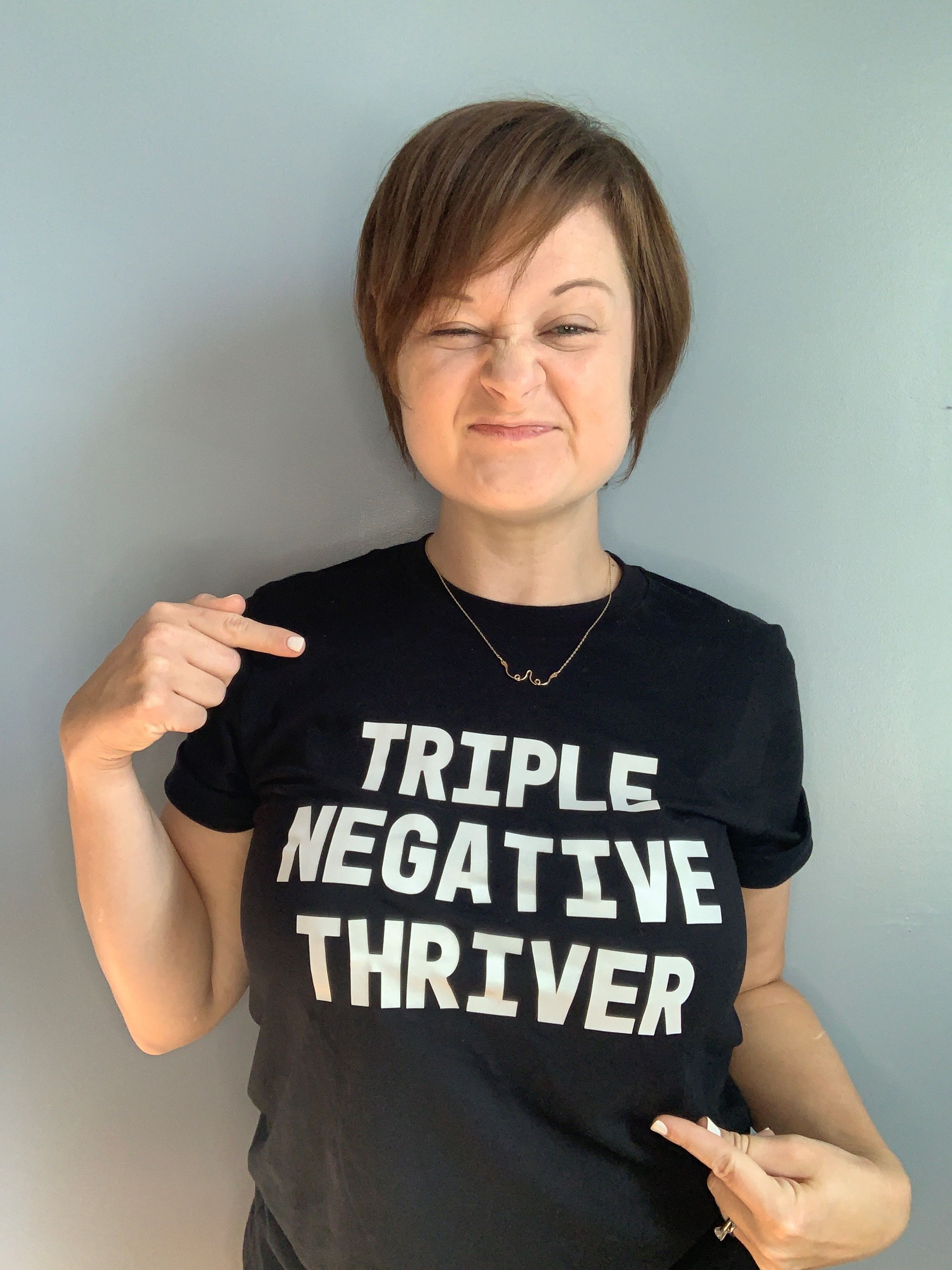Article
Evolving Paradigm of TNBC Means One-Size-Fits All No Longer Applies to Treatment
Author(s):
Over the past 20 years, chemotherapy has remained the primary treatment for triple-negative breast cancer. However, recent advancements have shown that a one-size-fits all treatment approach no longer works.
Kelly Thomas was relaxing on her couch on a Sunday morning in December 2017 when she folder her arms on her chest and immediately felt something unusual.
“I was like, ‘Oh, that wasn’t there the other day,” Thomas said in an interview with CURE®. “It was massive. … It felt like a golf ball was on my left boob.”
Thomas recalled that, instinctively, she knew something wasn’t right.
That’s because, for many years leading up to that Sunday in December, she had been a volunteer during several American Cancer Society breast cancer walks. Thomas worked in finance, and the company she had worked for was a partner of the American Cancer Society. During the walks, Thomas worked the financial tent collecting donations.
And although she didn’t have any family history of breast cancer, Thomas noted that her time spent participating at those cancer walks lead her to believe she had cancer.
“As soon as I felt (the lump), I thought about all the walks that I've done, and (how) it was always such an emotional experience for me,” she said. “And I thought, ‘I’m one of the ladies now.’ Like, even without my diagnosis, my gut was telling me that this is not good (and that) this is probably breast cancer.”
She made an appointment with her gynecologist, who said that young women — Thomas was 33 years old at the time — can sometimes get lumps on their breasts. Her gynecologist referred her to get a mammogram, and while she was undergoing the screening test, Thomas noted that, again, something was wrong.
“I see (the mammographer) pick up the phone, and she goes, ‘The doctor doesn’t like what he’s looking at. We have to do it again,’” she said.
She then walked across the hall to get an ultrasound. A week later, Thomas learned that she had stage 3 triple-negative breast cancer (TNBC).
What is Triple-Negative Breast Cancer?
Triple-negative disease is a form of breast cancer that is defined by the lack of estrogen receptor, progesterone receptor and HER2 expression. For women who have TNBC, there are no drivers behind what is causing the cancer to grow.
Or at least that used to be the case, according to Dr. Rita Nanda, director of the breast oncology program at University of Chicago Medicine.
In an interview with CURE®, Nanda explained that in the past, women would be categorized as either having HER2-positive or HER2-negative breast cancer. However, that all changed in June 2022 with the presentation of data that showed that treatment with Enhertu (fam-trastuzumab deruxtecan-nxki) appeared more effective than certain chemotherapies in women with HER2-low breast cancer.
Now, this “new” classification is being touted as a big leap forward. However, HER2-low disease, Nanda noted, is technically not “new.”
“HER2-low is an entity that we've all known for a while. … It’s not positive, but it’s not negative, it’s kind of in the middle,” she said.
But before the Enhertu data were presented, oncologists didn’t know what to do with that information, especially because HER2-low status didn’t affect a patient’s prognosis.
However, approximately one-third of patients with TNBC have low levels of HER2 expression, but again, didn’t fall under HER2-negative or HER2-positive, according to Nanda.
“Now, we are calling them hormone receptor-negative, HER2-low,” she said. “It’s a little in flux in what we want to call these patients; we’re still calling them triple negative, but they’re that segment that has HER2-low expression.”
A Year of Chemotherapy
Thomas said she began receiving treatment in February 2018, one month after she received her diagnosis of stage 3 TNBC.
Four years ago, Kelly Thomas received chemotherapy and a mastectomy to treat her triple-negative breast cancer (TNBC), though her treatment would be different if she were diagnosed more recently.
Photo courtesy of Kelly Thomas

Because her disease was so advanced — at least 10 of her surrounding lymph nodes were affected by the cancer — Thomas was administered neoadjuvant chemotherapy, or treatment that is given in advance of surgery to reduce the size of any existing tumors.
In her case, Thomas explained that she received four rounds of doxorubicin and cyclophosphamide, followed by eight rounds of paclitaxel and then four rounds of carboplatin.
She credited her oncologist for putting her on carboplatin, even though its mainly used in BRCA carriers — which Thomas was not.
After the 16 rounds of chemotherapy, Thomas underwent a double mastectomy — which is the complete surgical removal of both breasts. Following a delayed-breast reconstruction, Thomas’ oncologists identified that she did not derive a complete response to the treatment. Although the tumor was completely gone from her left breast, two of her lymph nodes had a presence of low-grade estrogen.
Luckily, she said, only 20% of the sample was cancerous. But that meant more treatment. She was then given 28 rounds of radiation to her left breast and armpit followed by an additional eight cycles of the chemotherapy capecitabine.
In all, Thomas started chemotherapy in February 2018 and finished in July 2019.
Stop Lumping Cancers Together
Although chemotherapy was, and still is, the primary treatment for early- and advanced-stage TNBC, Nanda highlighted that there have been several advancements that have changed the space over the past decade.
“We have some therapies that help all patients with TNBC and then some that are targeted therapies that only help subsets,” she said.
For instance, PARP inhibitors are best used to treat patients who have mutations in BRCA1 or BRCA2. Moreover, she explained, immunotherapy has been shown to benefit patients with PD-L1-positive TNBC.
Despite oncologists making progress to chip away at TNBC, so much more is still needed to move the field forward even further, according to Nanda.
“The reason we haven’t made those advances is because we’ve been lumping triple-negative breast cancer together as one entity, but it’s a very heterogeneous entity,” she said. “Some are PD-L1-positive, some have mutations, some are HER2-low. So the way we’re going to make advances is not by lumping them all together, right? If we lumped breast cancer together, we never would have made the advances we’ve made for HER2-positive disease or hormone receptor-positive disease. So it's really by taking this, 15% to 20% of breast cancers, and really understanding not what doesn't drive them, but what does drive them? And what can we use to treat these different subsets?”
In fact, chemotherapy has shown to be effective across HER2-positive disease, hormone receptor-positive disease and triple-negative disease. However, as Nanda expressed, chemotherapy isn’t targeted to a patient’s cancer but rather on rapidly dividing cells.
“If we truly want to make more substantial and significant advances, what we need to do is to really segment out these patients and figure out where we're heading as a field, not just in breast cancer, but overall, as in precision medicine, where we identify what is the best strategy to treat a particular cancer in a particular patient,” she said. “And that's how we're really going to move forward and make more substantial advances.”
Drastic Changes in a Short Period
Four years ago, Thomas received a cocktail of chemotherapies along with a double mastectomy and more than two dozen rounds of chemotherapy. However, if she were to have received the same diagnosis today, her treatment would have been drastically different.
“It’s completely amazing to me, because last time I met with my oncologist, he even said to me, ‘If you got diagnosed today, your treatment would have changed significantly,’” she said. “And I find it so interesting. As I like to say, ‘Back in my day, we did Red Devil (doxorubicin and cyclophosphamide) first.’ And now they save that for last.”
She said she even remembers the timeline of Keytruda (pembrolizumab) in TNBC. In November 2020, the Food and Drug Administration (FDA) approved Keytruda in combination with chemotherapy for patients with metastatic disease. Then in July 2021, the FDA approved Keytruda in combination with a chemotherapy regimen for patients with high-risk, early-stage TNBC.
“I tell my oncologist, that I kind of have FOMO (fear of missing out) because I didn't have Keytruda,” she said. “But on the other side of the coin, I'm so happy to that I did chemo four years ago and it has changed so much (since then). What is treatment for triple-negative breast cancer going to look four years from now? I think it's just going to keep advancing.”
For more news on cancer updates, research and education, don’t forget to subscribe to CURE®’s newsletters here.
To hear Thomas share what it was like to go from a volunteer to a patient with breast cancer and now an advocate for others, listen to this episode of the "Cancer Horizons" podcast.




